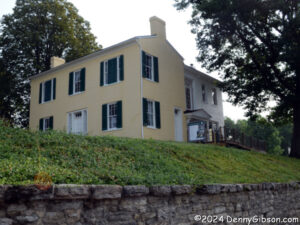 I have heard it said that Uncle Tom’s Cabin was written in this house. It was not. Until recently, I had not heard that it was listed in The Negro Motorist Green Book. It was.
I have heard it said that Uncle Tom’s Cabin was written in this house. It was not. Until recently, I had not heard that it was listed in The Negro Motorist Green Book. It was.
Although the book was not written here, Harriet Beecher Stowe, the author of Uncle Tom’s Cabin, did live in the house at one time and the house has long borne her name. It has just reopened after an extensive restoration that recognizes its importance both as the Beecher family home and as a tavern and boarding house a century later.
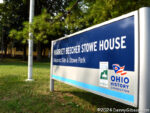
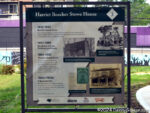
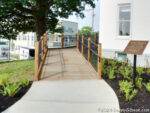 There was a ribbon cutting for the restored Harriet Beecher Stowe House last Friday with special events continuing through the weekend. I missed the “Housewarming Weekend” but did reserve a ticket for the first regularly scheduled tour on Thursday. The site is closed Monday through Wednesday. I arrived early enough to look over the many informative panels placed around the grounds. Note the National Register of Historic Places plaque with both of the building’s claims to fame listed, beside the new entrance ramp.
There was a ribbon cutting for the restored Harriet Beecher Stowe House last Friday with special events continuing through the weekend. I missed the “Housewarming Weekend” but did reserve a ticket for the first regularly scheduled tour on Thursday. The site is closed Monday through Wednesday. I arrived early enough to look over the many informative panels placed around the grounds. Note the National Register of Historic Places plaque with both of the building’s claims to fame listed, beside the new entrance ramp.
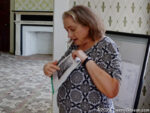 Executive Director Christina Hartlieb was our guide, and, despite it being the first “regularly scheduled” tour following the reopening, it was pretty obvious that this was not her first time as conductor. I’m guessing that the “Housewarming Weekend” had given her and other guides ample experience. It is also the case that much of the information provided is about the house’s residents and unchanged by the restoration.
Executive Director Christina Hartlieb was our guide, and, despite it being the first “regularly scheduled” tour following the reopening, it was pretty obvious that this was not her first time as conductor. I’m guessing that the “Housewarming Weekend” had given her and other guides ample experience. It is also the case that much of the information provided is about the house’s residents and unchanged by the restoration.
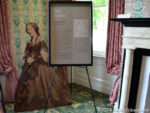
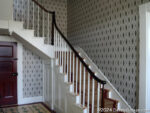
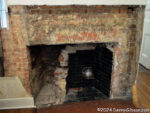 The house was built by Lane Seminary in 1833 as a home for its new president, Lyman Beecher. The Seminary is a most interesting part of history in its own right. Particularly the slavery-related debates of 1834 and a related mass exodus of students that has been called the “first major academic freedom incident in America”. The tour began in the parlor where 25-year-old Harriet Elisabeth Beecher became Mrs. Calvin Stowe in 1836. The original part of the house has been restored to its 1840 appearance. A strip of original wallpaper once covered by a temporary wall has been saved and copied. In the kitchen, the original beehive oven and its surroundings have been retained.
The house was built by Lane Seminary in 1833 as a home for its new president, Lyman Beecher. The Seminary is a most interesting part of history in its own right. Particularly the slavery-related debates of 1834 and a related mass exodus of students that has been called the “first major academic freedom incident in America”. The tour began in the parlor where 25-year-old Harriet Elisabeth Beecher became Mrs. Calvin Stowe in 1836. The original part of the house has been restored to its 1840 appearance. A strip of original wallpaper once covered by a temporary wall has been saved and copied. In the kitchen, the original beehive oven and its surroundings have been retained.
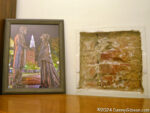

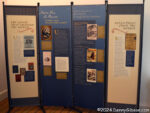 Even though Harriet lived in Cincinnati for less than twenty years, it was here, with slavery in operation just across the river and fallout from it everywhere she looked, that the memories that became Uncle Tom’s Cabin were formed. In an upstairs hallway, beside a section of original brick wall intentionally left exposed, there is a photo of the Hartford, CT, statue of Stowe’s meeting with Lincoln. There is no recording and no proof that Lincoln actually said, “So you’re the little lady who started this big war”, but I like to think he did.
Even though Harriet lived in Cincinnati for less than twenty years, it was here, with slavery in operation just across the river and fallout from it everywhere she looked, that the memories that became Uncle Tom’s Cabin were formed. In an upstairs hallway, beside a section of original brick wall intentionally left exposed, there is a photo of the Hartford, CT, statue of Stowe’s meeting with Lincoln. There is no recording and no proof that Lincoln actually said, “So you’re the little lady who started this big war”, but I like to think he did.


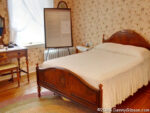 The Monfort family lived in the house from 1865 to 1930 and in 1908 they built a large addition. The addition’s exterior is currently painted white to distinguish it from the original building’s yellow. This was their formal dining room. During the 1930s and ’40s, it served as the Edgemont Tavern with a listing in The Negro Motorist Green Book. During that same period, the obviously updated second floor served as a boarding house. As a long-term residence rather than an overnight stop for tourists, only the tavern portion appeared in The Green Book. By coincidence, a traveling Green Book exhibit recently opened at the nearby National Underground Railroad Freedom Center and was the subject of a previous blog post.
The Monfort family lived in the house from 1865 to 1930 and in 1908 they built a large addition. The addition’s exterior is currently painted white to distinguish it from the original building’s yellow. This was their formal dining room. During the 1930s and ’40s, it served as the Edgemont Tavern with a listing in The Negro Motorist Green Book. During that same period, the obviously updated second floor served as a boarding house. As a long-term residence rather than an overnight stop for tourists, only the tavern portion appeared in The Green Book. By coincidence, a traveling Green Book exhibit recently opened at the nearby National Underground Railroad Freedom Center and was the subject of a previous blog post.
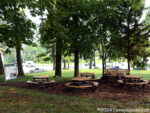 So, no, Uncle Tom’s Cabin was not written here but its author did live here, and a lot of other pretty darned important stuff also happened here. The Harriet Beecher Stowe House is back and ready to let you peek at 1840 and a little 1940 too.
So, no, Uncle Tom’s Cabin was not written here but its author did live here, and a lot of other pretty darned important stuff also happened here. The Harriet Beecher Stowe House is back and ready to let you peek at 1840 and a little 1940 too.

Denny, thank you for sharing your visit and the layers of history at this special home. We look forward to welcoming your readers!
I enjoyed my visit and appreciate that a tour of the house nudges people to think a bit about two important periods in history. Although I was aware of Lane Seminary’s connection to the Beecher family, I was not aware (or had forgotten) it’s role in some key events of the day. Thanks for reminding me, and thanks for the comment.